How to Brine and Roast a Cajun Turkey Like a Pro
Table of Contents
Cajun Turkey
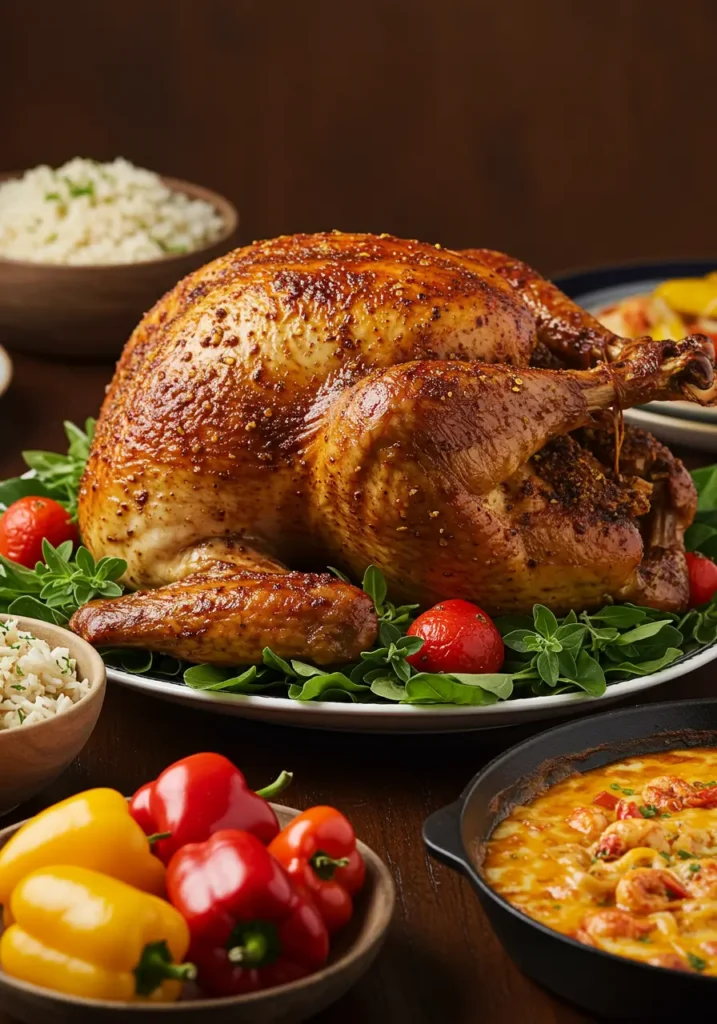
Tired of serving a dry, flavorless turkey at your holiday gatherings? You’re not alone. Many home cooks struggle with achieving that perfect balance of juicy meat and crispy skin. This Cajun turkey recipe will transform your bird into a show-stopping centerpiece with bold flavors and perfect texture.
As someone who has been perfecting turkey recipes for over a decade, I can confidently say that brining is the secret weapon for an unforgettable Cajun turkey. The spicy, savory notes of traditional Cajun seasoning paired with a proper brine creates a turkey that’s moist on the inside and beautifully seasoned throughout.
In this guide, I’ll walk you through everything from selecting the right turkey and creating the perfect Cajun brine to mastering the roasting process and serving suggestions. You’ll also find troubleshooting tips, FAQs, and variations to make this recipe your own.
Why This Cajun Turkey Recipe Works
- The wet brine ensures maximum moisture retention, eliminating the risk of dry turkey
- Cajun spices penetrate deep into the meat during the brining process
- The roasting technique creates perfectly crispy skin while keeping the meat juicy
- Make-ahead components reduce day-of stress for holiday meals
- Impressive presentation with minimal effort required
- Creates flavorful drippings for an incredible Cajun gravy
Choosing the Right Turkey
Best Turkey for Cajun Brining
For optimal results, select a fresh turkey between 12-15 pounds. This size range brines evenly and cooks more uniformly than larger birds. Avoid pre-brined, kosher, or self-basting turkeys, as these have already been treated with salt solutions that would make your final dish too salty.
Buying Tips
Look for turkeys labeled “natural” or “no additives.” If possible, opt for free-range or organic turkeys as they typically have better flavor. For the freshest option, order from a local butcher a week before your planned cooking date.
Substitutions
If turkey isn’t available, this Cajun brine works wonderfully with a large chicken (5-6 pounds) or even turkey breasts if you’re serving a smaller crowd. Simply adjust the brining and cooking times accordingly.
Ingredients & Prep
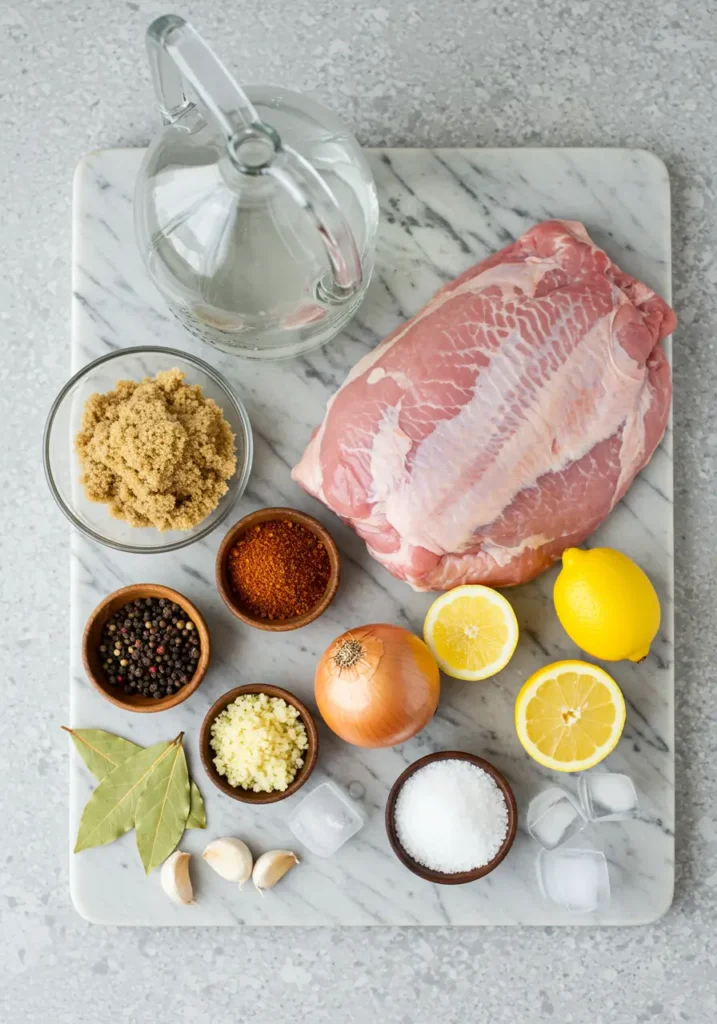
Brine Essentials
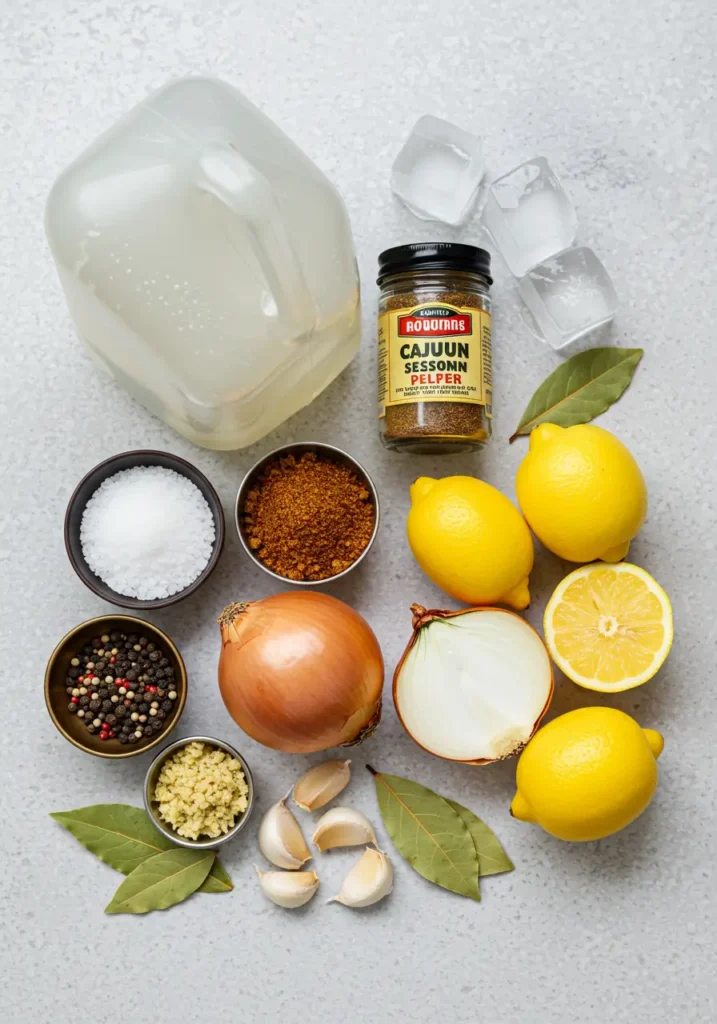
- 1 gallon cold water
- 1 cup kosher salt
- ¾ cup brown sugar
- ¼ cup Cajun seasoning blend
- 2 tablespoons black peppercorns
- 8 cloves garlic, crushed
- 3 bay leaves
- 1 large onion, quartered
- 2 lemons, halved
- 4 cups ice
Turkey Preparation
- 1 (12-15 pound) whole turkey, giblets and neck removed
- ¼ cup unsalted butter, softened
- 2 tablespoons Cajun seasoning blend
- 1 tablespoon olive oil
- 1 onion, quartered
- 1 head garlic, halved horizontally
- 2 celery stalks, roughly chopped
- Fresh thyme and rosemary sprigs
Homemade Cajun Seasoning
If you prefer to make your own Cajun seasoning:
- 2 tablespoons paprika
- 2 tablespoons garlic powder
- 1 tablespoon onion powder
- 1 tablespoon dried oregano
- 1 tablespoon dried thyme
- 1 tablespoon cayenne pepper (adjust to taste)
- 1 tablespoon black pepper
- 1 tablespoon white pepper
- 1 tablespoon salt
Step-by-Step Cooking Instructions
Brining Process
- Make the brine: In a large pot, combine 4 cups of water with salt, brown sugar, and Cajun seasoning. Heat over medium, stirring until salt and sugar dissolve completely. Remove from heat.
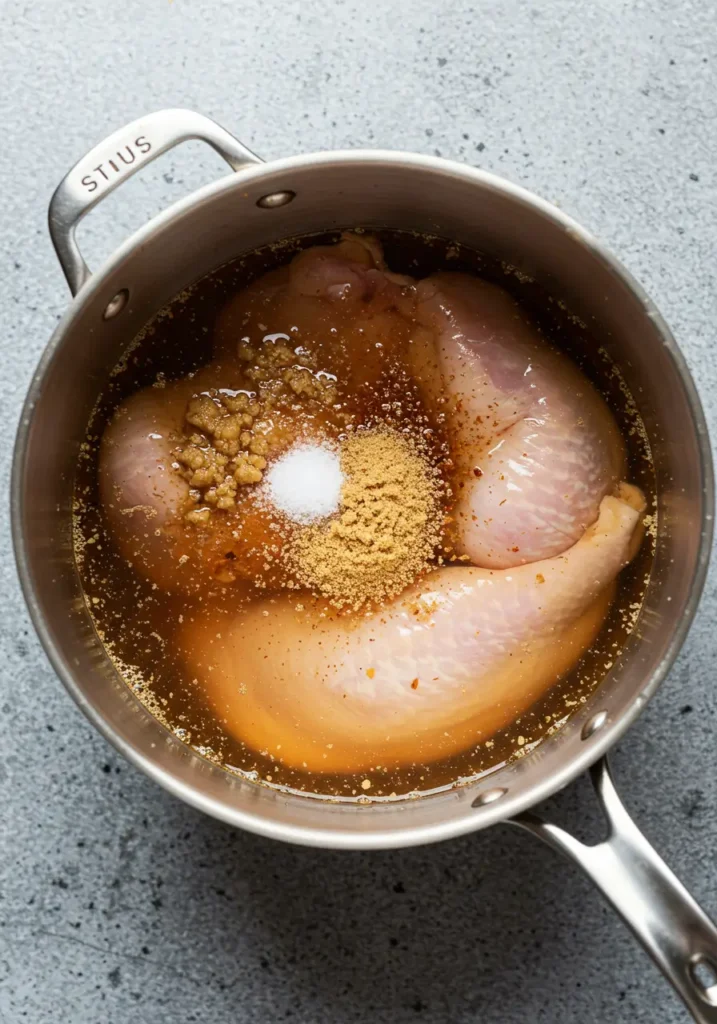
- Complete the brine: Add remaining brine ingredients (except ice) to the warm mixture. Let cool to room temperature, then add ice to chill completely.
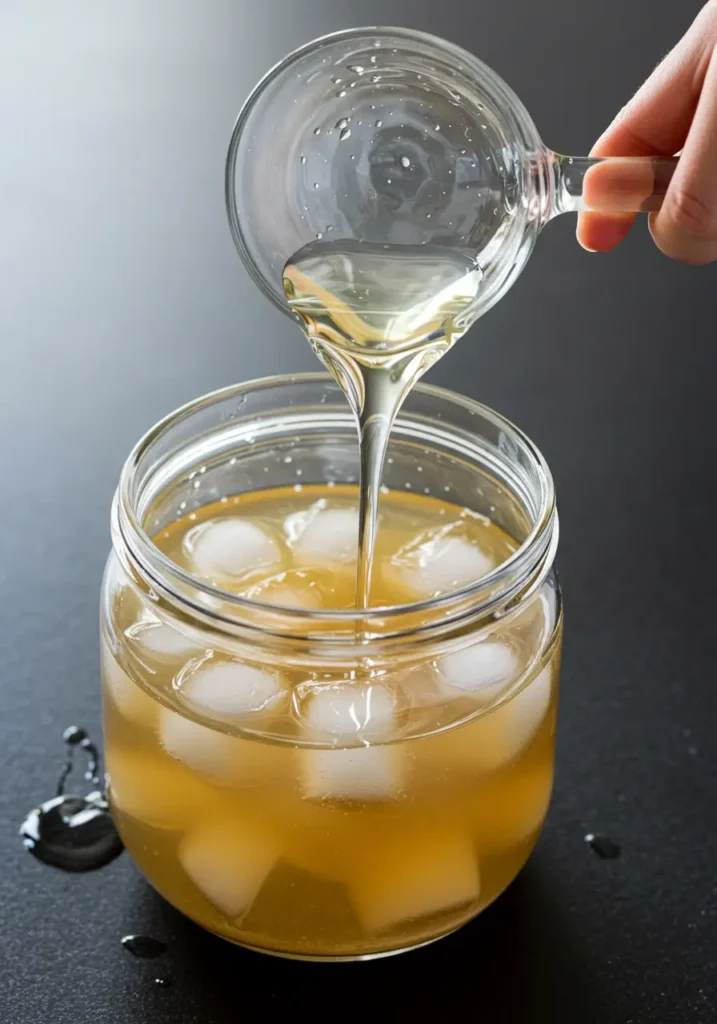
- Prepare the turkey: Rinse turkey thoroughly inside and out with cold water, then pat dry with paper towels.
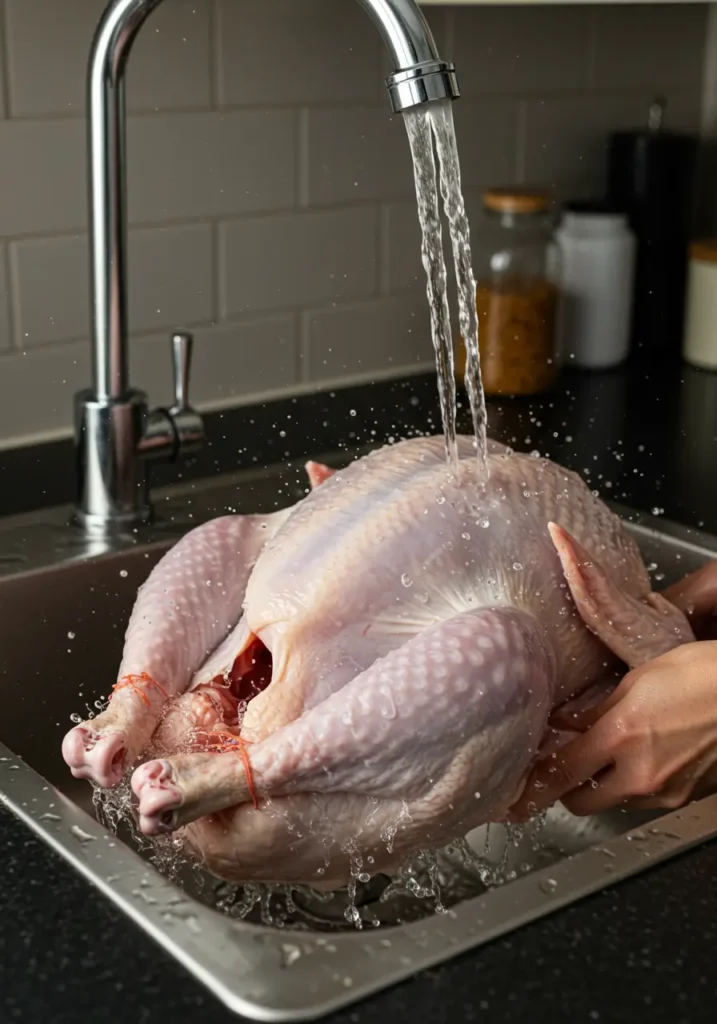
- Brine the turkey: Place turkey in a brining bag or large container. Pour the chilled brine over the turkey, ensuring it’s completely submerged. Seal and refrigerate for 12-24 hours (no longer, as the meat can become too salty).
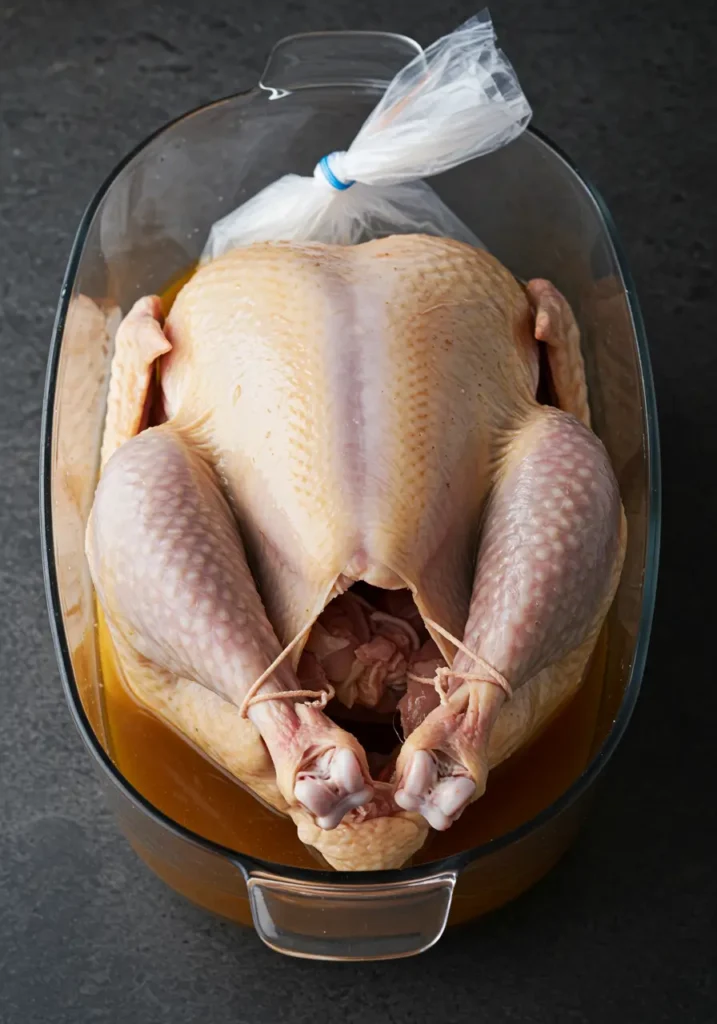
Roasting Preparation
- Remove from brine: Take the turkey out of the brine and rinse thoroughly with cold water. Discard the brine.
- Dry thoroughly: Pat the turkey completely dry with paper towels, inside and out. This is crucial for achieving crispy skin.
- Rest at room temperature: Allow the turkey to sit at room temperature for 1 hour before roasting.
- Preheat: Set your oven to 425°F (220°C).
- Prepare the cavity: Stuff the turkey cavity with onion quarters, garlic halves, celery, and herb sprigs.
- Season the skin: Mix softened butter with 2 tablespoons of Cajun seasoning. Carefully lift the skin over the breast and spread half the butter mixture directly on the meat. Rub the remaining butter all over the outside of the turkey. Brush the skin with olive oil.
Roasting Method
- Initial high heat: Place turkey breast-side up on a rack in a large roasting pan. Roast at 425°F for 30 minutes to brown the skin.
- Reduce temperature: Lower oven temperature to 325°F (165°C).
- Continue roasting: Cook until an instant-read thermometer inserted into the thickest part of the thigh (without touching bone) registers 165°F (74°C). This will take approximately 15 minutes per pound after the initial high-heat period.
- Tent if needed: If the skin browns too quickly, loosely tent with aluminum foil.
Resting Period
- Remove turkey from oven and tent loosely with foil.
- Let rest for at least 30 minutes (up to 45 minutes) before carving to allow juices to redistribute throughout the meat.
- Reserve pan drippings for Cajun gravy if desired.
Pro Tips for Perfect Cajun Turkey
Avoiding Dry Turkey
- Never skip the brining process – this is what ensures juicy meat
- Use a reliable meat thermometer rather than relying solely on cooking time
- Check multiple spots for doneness (thigh and breast), as they cook at different rates
- Don’t rush the resting period; it’s crucial for moisture retention
Tool Recommendations
- Large brining bag or food-grade container for the brining process
- Heavy-duty roasting pan with rack to elevate the turkey
- Instant-read thermometer for accurate temperature testing
- Kitchen twine for trussing (optional but helps with even cooking)
- Turkey baster or brush for basting
Storage & Reheating
- Refrigerate leftover turkey within two hours of carving
- Store in airtight containers for up to 4 days
- For longer storage, freeze sliced turkey in broth for up to 3 months
- Reheat with a splash of chicken broth to maintain moisture
- Use leftover turkey for Cajun turkey gumbo or jambalaya
Flavor Variations
Spicier Cajun Turkey
For heat lovers, double the cayenne pepper in your Cajun seasoning and add sliced jalapeños to the brine. You can also inject the turkey with a mixture of melted butter and hot sauce before roasting.
Herb-Forward Version
For a more herbaceous version, add fresh oregano, thyme, and sage to the brine and increase the amount of fresh herbs stuffed in the cavity.
Smoked Cajun Turkey
Take your Cajun turkey outdoors by smoking it instead of roasting. After brining, smoke at 225°F (107°C) using pecan or hickory wood until it reaches the proper internal temperature (approximately 30-40 minutes per pound).
Serving Suggestions
A Cajun turkey pairs wonderfully with Southern-inspired sides:
- Cornbread and andouille sausage stuffing
- Dirty rice
- Collard greens with bacon
- Cajun mac and cheese
- Sweet potato casserole
For beverages, consider:
- Spicy Bloody Marys
- Cold beer (try an amber ale or lager)
- Sweet tea (hot or iced)
- Bourbon-based cocktails
FAQs
Can I brine a frozen turkey?
No, your turkey should be completely thawed before brining. Thaw in the refrigerator allowing approximately 24 hours for every 4-5 pounds.
How much space do I need for brining?
Ensure you have enough refrigerator space for a container large enough to submerge the entire turkey in brine. Some people use coolers with ice packs if refrigerator space is limited.
Is Cajun turkey too spicy for children?
The brining process mellows the heat while enhancing flavor. For a more family-friendly version, reduce the cayenne pepper in your Cajun seasoning blend.
Can I stuff this turkey?
For food safety reasons, it’s better to cook stuffing separately when using a brined turkey. The brine can make stuffing too salty, and the added mass may prevent the turkey from cooking properly.
What if I don’t have time to brine?
While brining gives the best results, you can apply a dry Cajun rub under and over the skin, then let the seasoned turkey sit uncovered in the refrigerator overnight to help dry the skin for crispness.
Conclusion
Mastering the art of a perfectly brined and roasted Cajun turkey will revolutionize your holiday meals and special occasions. The combination of moist, flavorful meat with a kick of Cajun spices creates an unforgettable centerpiece that will have everyone coming back for seconds.
Take the plunge and try this Cajun turkey recipe for your next gathering. The prep work is simple, and the results are extraordinary. Once you experience how transformative brining can be, especially with bold Cajun flavors, you’ll never want to prepare turkey any other way.
Looking for more holiday inspiration? Check out our Complete Guide to Holiday Side Dishes or our Southern-Style Thanksgiving Menu for more ideas to round out your feast!Retry
Have You Tried Making Our Recipe?
There are no reviews yet. Be the first one to write one.



